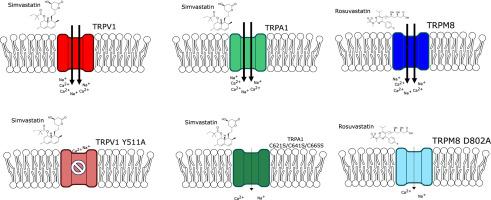他汀类药物激活温度门控瞬时受体电位离子通道
IF 4.7
3区 医学
Q1 PHARMACOLOGY & PHARMACY
引用次数: 0
摘要
他汀类药物是HMG-CoA还原酶抑制剂,用于降低低密度脂蛋白胆固醇水平和降低心血管疾病的风险。尽管他汀类药物耐受性相对较好,但有报道称其不良反应如肌痛和周围神经病变。虽然其根本原因尚未完全阐明,但越来越多的证据表明,他汀类药物在几种动物疼痛模型中具有多种多效作用,包括抗炎和镇痛作用。在这里,我们报道了一些最广泛使用的他汀类药物激活在异种系统中表达的温度门控瞬时受体电位(TRP)离子通道亚家族的成员。所有测试的他汀类药物(辛伐他汀、阿托伐他汀和瑞舒伐他汀)都能激活人TRPA1,此外,辛伐他汀能激活人TRPV1,瑞舒伐他汀能激活人TRPM8。辛伐他汀对TRPV1的激活在辣椒素不敏感突变体中被废除。此外,TRPV1和TRPA1对辛伐他汀的敏感性在已知表现出对活性氧敏感性降低的三倍半胱氨酸突变体中降低。瑞舒伐他汀诱导的TRPM8激活似乎涉及天冬氨酸残基,这对合成TRPM8激动剂icilin的敏感性至关重要。在小鼠背根神经节(DRG)神经元中,辛伐他汀激活的神经元亚群也对trpa1激动剂辣椒素或trpa1激动剂异硫氰酸烯丙酯有反应。此外,TRPM8在瑞舒伐他汀激活少量DRG神经元中起重要作用。综上所述,这些结果表明他汀类药物激活了在伤害感觉神经元中表达的热敏TRP通道。这种性质可以解释这些广泛使用的药物的一些多效性。本文章由计算机程序翻译,如有差异,请以英文原文为准。

Statins activate temperature-gated transient receptor potential ion channels
Statins are HMG-CoA reductase inhibitors administered to decrease levels of LDL cholesterol and to lower the risk of cardiovascular disease. Although statins are relatively well tolerated, adverse effects such as myalgia and painful peripheral neuropathy have been reported. While the underlying cause has not been fully elucidated, accumulating evidence shows that statins have numerous pleiotropic effects including anti-inflammatory and analgesic actions in several animal pain models. Here we report that some of the most extensively used statins activate members of the temperature-gated transient receptor potential (TRP) ion channel subfamily expressed in heterologous systems. All tested statins (simvastatin, atorvastatin and rosuvastatin) activate human TRPA1 and, in addition, simvastatin activates human TRPV1 and rosuvastatin activates human TRPM8. The activation of TRPV1 by simvastatin is abolished in a capsaicin-insensitive mutant. Furthermore, the sensitivities of both TRPV1 and TRPA1 to simvastatin are diminished in triple cysteine mutants known to exhibit a reduced sensitivity to reactive oxygen species. Rosuvastatin-induced activation of TRPM8 seems to involve an aspartate residue which is essential for sensitivity to the synthetic TRPM8-agonist icilin. In mouse dorsal root ganglion (DRG) neurons, simvastatin activates a subpopulation of neurons which also respond to the TRPV1-agonist capsaicin or the TRPA1-agonist allyl isothiocyanate. In addition, TRPM8 plays an important role for the activation of a small population of DRG neurons by rosuvastatin. Taken together, these results indicate that statins activate thermo-sensitive TRP channels expressed in nociceptive sensory neurons. This property may explain some of the pleiotropic effects of these widely used drugs.
求助全文
通过发布文献求助,成功后即可免费获取论文全文。
去求助
来源期刊
CiteScore
9.00
自引率
0.00%
发文量
572
审稿时长
34 days
期刊介绍:
The European Journal of Pharmacology publishes research papers covering all aspects of experimental pharmacology with focus on the mechanism of action of structurally identified compounds affecting biological systems.
The scope includes:
Behavioural pharmacology
Neuropharmacology and analgesia
Cardiovascular pharmacology
Pulmonary, gastrointestinal and urogenital pharmacology
Endocrine pharmacology
Immunopharmacology and inflammation
Molecular and cellular pharmacology
Regenerative pharmacology
Biologicals and biotherapeutics
Translational pharmacology
Nutriceutical pharmacology.

 求助内容:
求助内容: 应助结果提醒方式:
应助结果提醒方式:


